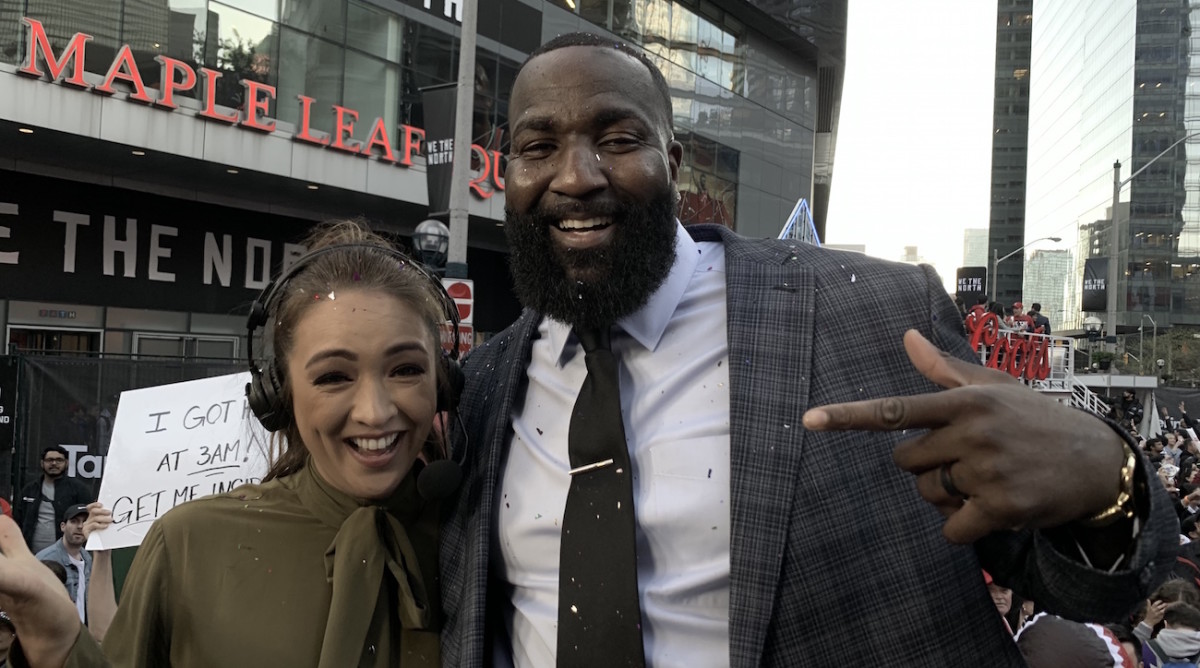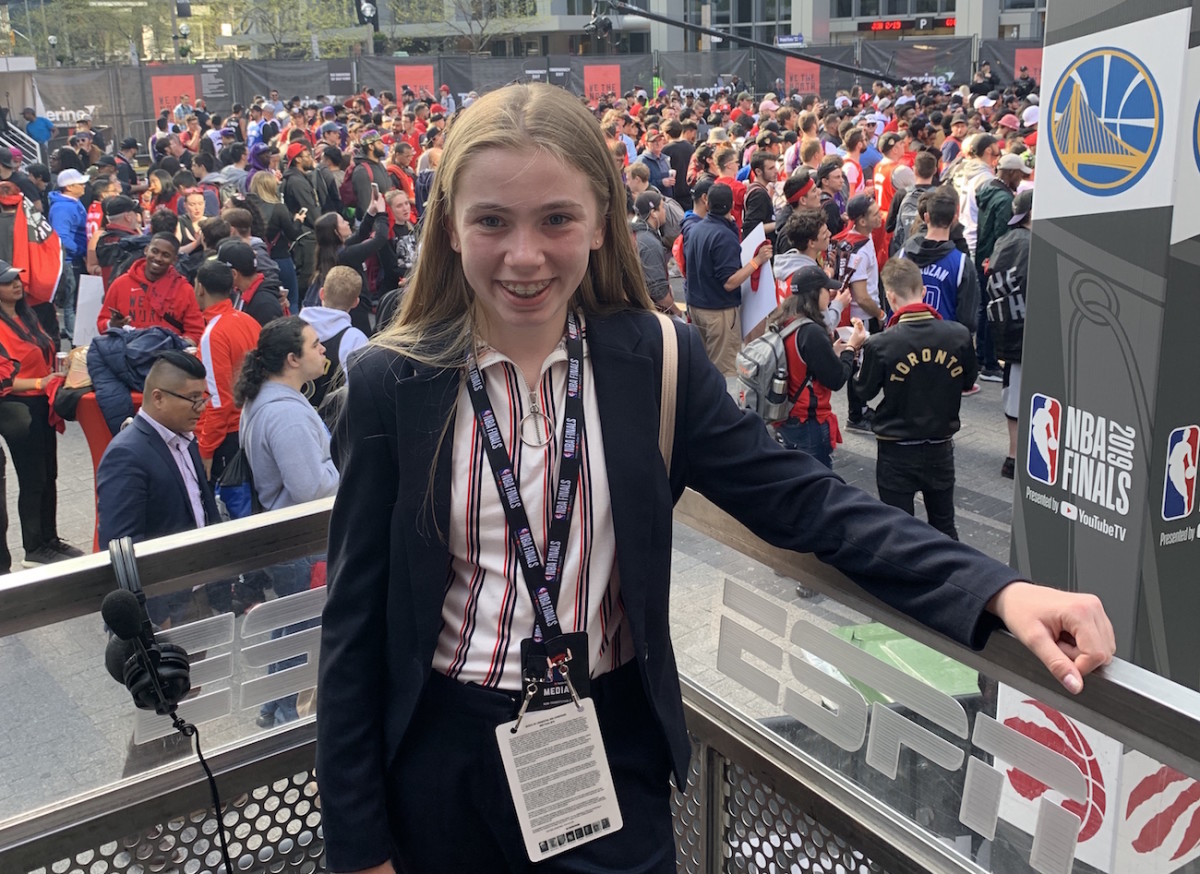ESPN's Cassidy Hubbarth Talks Dreams and Hoop Streams

The NBA Finals are in full swing, and I was at Game 2 in Toronto to interview ESPN’s Cassidy Hubbarth and watch her show, Hoop Streams. It’s a social media pregame program that launched earlier this year and airs on Twitter, YouTube Live, and the ESPN app. During the Finals, the show has had 1.8 million total views per game, with an average of 102,000 per minute.
The 34-year-old Hubbarth, who is from Chicago, dreamed early on of being a sports broadcaster, followed her dream, paid her dues, and now works on a show that she’s very passionate about. And one that covers her favourite sport: basketball. When I visited, it was filmed in Jurassic Park, Toronto’s outdoor viewing party, and the atmosphere was amazing! Hubbarth’s show was energetic, fast-paced, fun, and covered all the things fans would want to know before the game. I sat courtside with Hubbarth before the show’s taping, and we talked about Hoop Streams and what it’s like being a female broadcaster in a male-dominated profession.
Who came up with the idea for the show?
Our social team at ESPN, a few guys by the name of Mike Foss, Ryan Spoon, and Steve Braband. The concept came from the fact that we know there’s an audience to reach via social media and that a lot of people spend their time on their devices and not sitting in front of a television. So this was a way to reach those audiences and get content to them and [get them to] want to watch the NBA.
What does your day look like, from preparing for the show to the end of the show?
Really I start preparing a couple days before the show, having phone calls and meetings with my producers where we’re brainstorming ideas and getting a guest list. For a show like this we’re going to have a lot of guests coming in and out, so we spend time lining those guests up. We talk to team representatives to see what fun little events we can do like food or bringing the mascots in. A lot of it is preparing what content we’re going to have in the show. The day of, I have a couple more production calls to finalize the order and flow of the show. I write my scripts, I report to the arena, I get hair and makeup done, we do some tech testing, and then we go live!
What sort of guests do you have on your show?
Tonight, for example, we have three NBA champions on the show: Richard Jefferson, Kendrick Perkins (below), and Shawn Marion. We have two of our biggest personalities from the U.S., in Pablo Torre and Bomani Jones, who have their own show called High Noon. We have a former Bachelorette, Rachel Lindsay, who is pursuing a career in sports broadcasting and who I’m excited to be working with. We have a packed show!

What aspects of the NBA does Hoop Streams talk about?
Obviously we talk about the X’s and O’s of the game with our analysts, but we try to dig deeper into the fan experience both in the arena and at home. We like to interact with fans on social media, see what they’re tweeting about, and we also really like to showcase what’s happening on-site. We’ve had players crash our show, whether they’re talking to our analysts or just saying “hi” to us. So that type of wall being broken down is what we’re looking for. We want to show fans at home that not everything needs to be buttoned up and that we’re out here with the players, with the coaches, and with the fans.
What, ultimately, is Hoop Streams trying to achieve?
We’re trying to reach as many NBA fans as possible to get them to be more interested in what’s happening in the NBA. To entertain, inform, and to galvanize NBA fans. We really try to promote the game on-air and try and get the fans to feel a part of the party that is this league.
What made you want to be a sports broadcaster?
I’ve always had a dream of working in sports broadcasting. I grew up as an athlete. My dad was always my coach, and in middle school I realized this was the career I wanted to pursue. In high school I called the boys basketball games and was part of the radio, television, and film club. I went to college for broadcast journalism, so I’ve always found whatever was the next step to get me to where I am, which is my dream job! Growing up, my biggest passion in sports was the NBA. I grew up in Chicago. I was a Bulls fan during the Jordan era, so I fell in love with the NBA. To cover it now really is a dream come true!
What sports did you play growing up?
I played basketball, soccer, and softball, and I swam and ran cross-country. Soccer and basketball were my two biggest sports.
Who had the biggest impact on you pursuing this career?
I’ve had so many mentors, and you’ll find out along the way that you’ll have a lot of different people who will shape your career and shape the decisions you’re going to have to make. Really there’s no one way to get to this point in your career. I’m so fortunate that I’ve had a lot of people help me and give me opportunities that I feel I’ve taken advantage of, which has helped me get to this stage I’m at now.
Where did your broadcasting career start?
It started in Chicago. I worked at the NBC station there as a traffic reporter, but I also worked at a sports production company called Inner Sports as a production assistant. I worked in production and on-air for a couple years until moving to on-air full-time. A big part of my passion for this business is being hands-on, creative—being part of the process and knowing what’s going on behind camera. I think that’s what has helped me stand out. This business is constantly changing, and you have to understand how it’s changing and how employers and networks are trying to attract more viewers and reach their viewers. That’s something I have a passion for, studying those trends, and I’m really proud of that.

What is it like being a woman in this industry?
It’s complicated. It is a male-dominated business, but at the same time I do feel I’ve gotten opportunities because I am a woman. So I will say that there are times I have been noticed more, but I say this: I also get noticed more! I don’t get the same benefit of the doubt as some of my male counterparts. And sometimes I have to deal with certain critiques of my appearance that my male counterparts may not have to deal with. Aside from that, I do feel that the business is changing a lot. I feel like I’m seeing a lot more women not just in front of the camera, but behind the scenes. I work with female producers, female directors, female executives. There’s still not enough, but if you look at ESPN covering the NBA, women are all in major roles and seats! The host of our NBA Countdown show is a woman; the host of our daily NBA show is a woman; the host of our social media show is a woman; and probably the biggest star of our broadcasts, Doris Burke, is a woman. I do feel that there’s a lot of positive changes and that the women before me have paved the way and have created more opportunities for women like myself to prosper.
What would you say to the young girl who wants to grow up and be a broadcaster?
Follow your dreams! It is an incredible career path and journey, but it will not be easy. It is something that will continue to challenge you and continue to make you reinvent yourself and test yourself. You constantly need to make sure you want to learn. You have to have a curiosity in this business; you can’t just want to be on television. You have to be genuinely passionate about sports, about competition, about production. Viewers and readers can see through if you’re trying to fake it, if you’re just trying to be there and not really be a part of the process.
What obstacles do female broadcasters have to still overcome?
I think we have to overcome people judging us by our covers. I see it not being an issue when they prove they are really good at their jobs! That they work hard, they’ve earned the respect of their peers, and that they really put into the work to be here. I think that’s when you’ll see it doesn’t matter what you look like or how you present yourself; it matters if your work is good.
